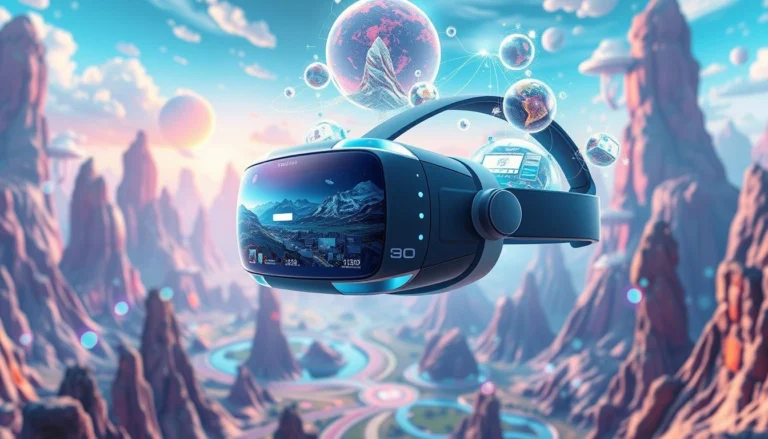Mastering 2025 Tech Trends for Business Growth
The 2025 Tech Playbook: Navigating the Digital Frontier for Unprecedented Business Growth
Estimated Reading Time: 21 minutes
Key Takeaways
- The 2025 tech landscape is defined by AI automation, advanced web and mobile development, optimized cloud & DevOps, and user-centric UI/UX design.
- Next-generation web and mobile apps will prioritize performance, personalization, and cross-platform compatibility, leveraging frameworks like Next.js and Flutter.
- Cloud computing, especially serverless architecture and robust DevOps practices, will form the scalable backbone for modern operations.
- AI automation will transform business workflows and customer service, demanding responsible and ethical development practices.
- Digital transformation requires strategic adoption of these trends, with a focus on optimization and user experience for businesses of all sizes.
Table of Contents
- Introduction: Navigating the Digital Frontier of 2025
- The Evolving Landscape of Web Development in 2025
- Mobile App Innovation: A Seamless Digital Lifestyle
- Cloud Computing & DevOps: The Backbone of Modern Operations
- AI Automation for Businesses: Intelligence at Scale
- Modern UI/UX Design: Crafting Intuitive Digital Experiences
- Digital Transformation Strategies: Empowering Businesses of All Sizes
- The AITechScope Advantage: Your Partner in 2025 Tech Adoption
- Frequently Asked Questions (FAQs)
- Conclusion: Embracing the Future of Technology
Introduction: Navigating the Digital Frontier of 2025
The digital landscape is a relentless force of innovation, constantly reshaping how businesses operate, how consumers interact, and how developers build. As we cast our gaze towards 2025, the convergence of advanced technologies promises a paradigm shift, moving beyond mere incremental improvements to truly transformative capabilities. This isn’t just about adopting new tools; it’s about fundamentally rethinking strategies for growth, efficiency, and competitive advantage.
This comprehensive guide serves as your 2025 tech playbook, a deep dive into the pivotal 2025 tech trends that are set to define the next era. We’ll explore the dynamic evolution of web development trends, the cutting-edge of mobile app development 2025, the foundational power of cloud computing and DevOps, the disruptive potential of AI automation for businesses, and the critical importance of modern UI/UX design. Whether you’re a business owner seeking to future-proof your operations, a developer eager to master the next-gen tech stack, or a tech enthusiast curious about what’s next, this article breaks down complex innovations into actionable insights. We’ll illuminate how these interconnected trends are not just buzzwords but crucial digital transformation strategies that can accelerate growth, drastically improve performance, and fundamentally transform the way companies operate.
At AITechScope, we stand at the forefront of this revolution. Specializing in AI-powered automation, n8n workflow development, and business process optimization, we empower businesses to intelligently delegate tasks and scale operations. Our expertise lies in helping companies leverage these tech innovation for small businesses and large enterprises alike, reducing costs and boosting efficiency through intelligent delegation and automation solutions – a central theme as we explore the future of technology.
The Evolving Landscape of Web Development in 2025
The web development landscape is undergoing a dramatic metamorphosis, driven by demands for speed, security, and an increasingly dynamic user experience. In 2025, web applications are no longer just about presenting information; they are immersive, intelligent, and deeply integrated platforms that demand a tech stack for modern businesses that prioritizes performance and scalability. The focus is shifting towards more efficient rendering, modular architectures, and the seamless integration of artificial intelligence.
Next-Generation Front-Ends: Performance and User Experience
The quest for lightning-fast load times and buttery-smooth user interfaces continues to drive innovation in front-end development. In 2025, frameworks like Next.js and React are not just popular; they are becoming the gold standard for high-performance web applications.
- Next.js and React Performance:
Next.js and React performanceis paramount. Next.js, built on React, excels by offering features like server-side rendering (SSR), static site generation (SSG), and incremental static regeneration (ISR). These capabilities drastically reduce initial page load times and improve SEO, providing a significant advantage in a competitive online world. For businesses, this means better search rankings, lower bounce rates, and ultimately, higher conversion rates. Developers are increasingly mastering techniques for 5 Simple React Performance Fixes – such as lazy loading components, memoization, and optimizing state management – to squeeze every ounce of speed out of their applications. - Rapid Development for Business: For startups and small businesses, the ability to launch quickly and iterate rapidly is critical. Next.js for small businesses offers a compelling solution. It provides a robust framework for building a
fast marketing site Next.jsin a fraction of the time compared to traditional approaches. Its opinionated structure reduces decision fatigue, while its performance benefits ensure that even basic marketing sites deliver a premium user experience from day one. A Next.js beginner guide would emphasize its intuitive file-system routing and API routes, making it accessible for developers entering the modern web stack. - The Rise of Edge Computing: Beyond SSR and SSG, edge computing is gaining traction. By serving content closer to the user, the time-to-first-byte is minimized, further enhancing the user experience. Next.js, with its ability to deploy to platforms like Vercel which leverage edge functions, is perfectly positioned for this trend.
Beyond Monoliths: Microservices and Headless Architectures
The monolithic application, while still present, is increasingly giving way to more flexible, scalable, and maintainable architectures. Microservices architecture and headless content management systems are at the forefront of this shift, enabling AI-powered web apps and more dynamic digital experiences.
- Microservices Architecture: In 2025,
microservices architectureis not just for tech giants. Small to medium-sized enterprises (SMEs) are adopting it to create more resilient and scalable applications. By breaking down an application into smaller, independent services, teams can develop, deploy, and scale components independently. This fosters agility and reduces the risk associated with large, complex deployments. While Micro Frontends can offer benefits for large teams working on complex UIs, careful consideration is needed to avoid unnecessary complexity; knowing When They Help and When They Hurt is key. - Headless CMS and WordPress: The concept of a headless CMS WordPress is revolutionizing content delivery. Decoupling the content management backend from the front-end presentation layer allows content to be served to any device or platform – be it a traditional website, a mobile app, an IoT device, or even a smart speaker. This flexibility, combined with WordPress’s familiar authoring experience, makes it an attractive option for businesses looking to future-proof their content strategy without sacrificing ease of use. This approach helps create a WordPress Without the Bloat as the frontend can be built with modern, lightweight frameworks.
- AI-Powered Web Apps: The integration of AI directly into web applications is no longer a futuristic concept but a growing reality. From personalized content recommendations and dynamic UI adjustments to intelligent search and predictive analytics,
AI-powered web appsleverage machine learning to create more intelligent, adaptive, and engaging user experiences. This means developers need to become more familiar with AI APIs and frameworks, bridging the gap between data science and front-end development.
Responsive and Inclusive UI Design: The Standard, Not an Option
In an increasingly multi-device world, responsive UI design is no longer a luxury but an absolute necessity. However, 2025 brings an elevated focus on true inclusivity and accessibility, moving beyond just adapting to screen sizes.
- Holistic Responsive Design:
Responsive UI designin 2025 encompasses not just breakpoints but also performance optimization for different network conditions, touch vs. mouse interactions, and various input methods (voice, gesture). The goal is a truly fluid experience, regardless of how or where a user accesses your web application. - Modern UI/UX Principles:
Modern UI/UX designprinciples emphasize simplicity, clarity, and delight. Designers are focused on reducing cognitive load, creating intuitive navigation, and using micro-interactions to enhance feedback and engagement. This includes a strong emphasis on Designing Accessible Buttons and other components, ensuring that applications are usable by everyone, regardless of ability. This not only broadens market reach but also reflects ethical development practices. - Adaptive Interfaces: With the rise of AI, UIs are becoming more adaptive. They learn user preferences, anticipate needs, and even modify their layout or content based on context, behavior, and even emotional cues, moving towards truly personalized digital spaces.
Mobile App Innovation: A Seamless Digital Lifestyle
Mobile applications remain the primary touchpoint for billions worldwide, and mobile app development 2025 is poised for significant innovation. The focus is on creating highly performant, deeply personalized, and universally accessible experiences that blur the lines between physical and digital worlds. The ongoing debate between native and cross-platform development continues, with significant advancements making the latter increasingly viable for many businesses.
Cross-Platform Supremacy: Flutter vs React Native in 2025
The choice of which mobile framework for startups or established businesses often boils down to a fundamental decision between native development and cross-platform solutions. In 2025, Flutter vs React Native remains a key discussion, but both have matured considerably, offering powerful capabilities.
- Flutter’s Ascent: Flutter, Google’s UI toolkit, has gained immense traction due to its “write once, deploy everywhere” philosophy and its exceptional performance, often rivaling native apps. Its declarative UI and hot-reload feature significantly speed up development cycles. For
mobile app development 2025, Flutter offers a compelling package, allowing businesses to reach iOS, Android, web, and desktop audiences from a single codebase. Learning How to Build a Simple Cross-Platform App with Flutter: From Idea to Play Store has become a common goal for many developers. - React Native’s Endurance: React Native, Facebook’s framework, continues to be a powerhouse, leveraging the vast React ecosystem and JavaScript community. Its ability to integrate native modules allows for seamless access to device-specific features, and its maturity means a rich library of components and an extensive developer community.
- The Verdict for 2025: The
React Native vs Flutter 2025debate doesn’t have a single winner. Flutter often shines for apps requiring highly custom UIs and maximum performance consistency across platforms, making it ideal formobile app UI trendsfocused on rich, animated experiences. React Native remains strong for businesses with existing React web teams or those needing deeper native integration without going fully native. The best choice ultimately depends on team expertise, specific app requirements, and long-term maintenance strategy. Both offer excellent paths formobile app development 2025.
AI-Powered Mobile Experiences and Intuitive UI
Beyond the underlying framework, the user experience of mobile apps in 2025 will be profoundly shaped by artificial intelligence and increasingly sophisticated mobile app UI trends.
- Hyper-Personalization with AI: AI is enabling mobile apps to offer truly hyper-personalized experiences. From intelligent content feeds and predictive suggestions to dynamic interfaces that adapt to user behavior and context, AI makes apps feel more intuitive and indispensable. This includes leveraging machine learning for fraud detection, personalized health insights (as seen with Philips deepening integration of Cortechs.ai neuroimaging tools into MR systems), and intelligent travel planning.
- Voice, Gesture, and AR/VR Integration:
Mobile app UI trendsare moving beyond touch. Voice interfaces, gesture controls, and augmented reality (AR) and virtual reality (VR) integrations are becoming more common. Apps are increasingly designed to understand natural language commands, respond to intuitive gestures, and overlay digital information onto the real world, creating richer, more interactive experiences. This shifts UI/UX design from purely visual to multi-sensory interactions. - Contextual Awareness: Mobile apps will leverage more sensor data (location, activity, environment) combined with AI to become contextually aware. An app might proactively offer relevant information or actions based on where a user is, what time it is, or what they’re doing, making digital interactions feel predictive and effortless.
Cloud Computing & DevOps: The Backbone of Modern Operations
Cloud computing is no longer an emerging technology; it’s the default infrastructure for modern businesses. In 2025, the focus shifts to optimizing cloud utilization, embracing serverless architectures, and solidifying DevOps best practices through robust CI/CD automation. These elements form the critical backbone for scaling operations, improving reliability, and driving enterprise digital adoption.
Serverless Architecture: Efficiency and Scalability
Serverless architecture is moving from niche adoption to mainstream, offering unparalleled efficiency and scalability for applications of all sizes.
- True Elasticity and Cost-Efficiency: The core promise of serverless is that you only pay for the compute resources you consume. This model, often exemplified by a serverless AWS cost example where functions run only when triggered, can lead to significant cost savings compared to always-on servers. For a
serverless backend for startups, this is a game-changer, allowing them to build highly scalable applications without the upfront infrastructure investment or the operational overhead of managing servers. - Accelerated Development and Deployment: Serverless frameworks abstract away infrastructure concerns, allowing developers to focus purely on writing code. This dramatically accelerates development cycles and simplifies deployment. Serverless on AWS: Create a Cost-Efficient Backend That Scales Automatically demonstrates how easily functions can be deployed and managed, scaling instantly from zero to millions of requests without manual intervention.
- Microservices’ Natural Partner: Serverless functions are a natural fit for
microservices architecture, allowing individual services to be deployed and scaled independently as lightweight, event-driven units. This further enhances agility and resilience.
DevOps Best Practices and CI/CD Automation
DevOps best practices are critical for bridging the gap between development and operations, fostering a culture of collaboration, and accelerating software delivery. CI/CD automation is the engine that drives this efficiency.
- Integrated DevOps Culture: In 2025, DevOps is less about tools and more about culture – breaking down silos between teams, sharing responsibilities, and automating repetitive tasks. This includes continuous feedback loops, proactive monitoring, and a commitment to infrastructure as code.
- The Power of CI/CD:
CI/CD automation(Continuous Integration/Continuous Delivery) is non-negotiable for modernsoftware development 2025. It ensures that code changes are frequently integrated, tested, and deployed, reducing bugs and speeding up time-to-market. For aCI CD small team, tools like GitHub Actions are invaluable. A GitHub Actions deploy tutorial can quickly show how to set up automated workflows that build, test, and deploy code to various environments (like AWS S3 for static sites or AWS Lambda for serverless functions) with every commit. - Streamlined for Small Teams: The good news is that CI/CD for Small Teams: Automated Deployments Without the Headache is more achievable than ever. Cloud-native tools and platform-as-a-service offerings simplify the setup, allowing small teams to enjoy the benefits of automation without needing a dedicated DevOps engineer. This efficiency is crucial for
tech innovation for small businessesthat need to compete with larger enterprises.
Strategic Cloud Migration for Enterprise Digital Adoption
While cloud adoption is widespread, cloud migration strategy remains a significant undertaking for many established enterprises. In 2025, the focus is on smarter, more strategic migrations that minimize disruption and maximize long-term benefits for enterprise digital adoption.
- Phased Migration Approaches: Rather than a “lift and shift” of entire legacy systems, organizations are adopting phased
cloud migration strategyapproaches. This might involve migrating less critical applications first, re-platforming specific components, or leveraging hybrid cloud solutions. The goal is to move How to Move Your Legacy App to the Cloud Without Breaking It, ensuring business continuity throughout the process. - Optimizing Cloud Resources: Post-migration, continuous optimization is key. This includes right-sizing instances, leveraging serverless for appropriate workloads, implementing robust cost management tools, and automating resource scaling. Effective
cloud computing and DevOpspractices are essential for ensuring that cloud investments deliver maximum ROI. - Fueling Digital Adoption: Cloud infrastructure is a fundamental enabler of
digital transformation strategies. It provides the flexibility, scalability, and global reach necessary to support new digital products, services, and operational models, empowering organizations to fully embraceenterprise digital adoption.
AI Automation for Businesses: Intelligence at Scale
Artificial Intelligence is no longer a futuristic concept but a tangible, transformative force. AI automation for businesses in 2025 is about leveraging intelligent systems to optimize processes, enhance decision-making, and liberate human potential from repetitive tasks, driving unprecedented efficiency and innovation.
Transforming Workflows with AI and No-Code Solutions
The combination of AI and no-code/low-code platforms is democratizing automation, making it accessible to a wider range of businesses and even non-technical users.
- Empowering Workflow Automation:
Workflow automation tools, increasingly powered by AI, are reshaping how businesses manage their operations. From automating data entry and report generation to streamlining customer onboarding and supply chain logistics, AI is injecting intelligence into every step. AITechScope specializes inn8n workflow development, leveraging AI to create sophisticated, integrated automation solutions that scale operations and reduce manual effort. We help businesses Automate Repetitive Tasks with No-Code Tools + AI (Save 5–10 Hours/Week), freeing up valuable employee time for strategic initiatives. - Intelligent Delegation and Optimization: AI-powered virtual assistants are moving beyond simple chatbots to sophisticated tools that can perform complex tasks, analyze data, and even make semi-autonomous decisions. This concept of
intelligent delegationis central tobusiness process optimization, allowing companies to achieve more with fewer resources. - SaaS Product Optimization: For SaaS providers,
SaaS product optimizationincreasingly involves embedding AI directly into their offerings. This can range from AI-driven analytics that suggest user improvements to automated content generation or intelligent feature recommendations, delighting users and increasing engagement.
Chatbot Automation and AI for Customer Service Excellence
Chatbot automation has evolved significantly, moving from rule-based systems to highly intelligent, AI-powered conversational agents that provide superior AI chatbots for customer service.
- Next-Gen Customer Support: In 2025, AI chatbots are capable of understanding complex queries, handling multi-turn conversations, and resolving a wide range of customer issues without human intervention. They provide instant support 24/7, reducing wait times and improving customer satisfaction. Real-world workflows show How Small Businesses Use Chatbots to Save Time: Real Workflows That Work, handling FAQs, qualifying leads, and even processing simple transactions.
- Personalized Interactions: Beyond basic support, AI chatbots leverage customer data and machine learning to offer personalized recommendations, upsell opportunities, and proactive assistance, transforming customer service into a personalized engagement channel. This is a key component of
digital transformation strategies. - Empowering Human Agents: Far from replacing human agents, AI chatbots empower them by handling routine inquiries, providing quick access to information, and summarizing customer interactions, allowing human teams to focus on more complex and empathetic issues.
Responsible AI: Navigating the Ethical and Security Landscape
As AI becomes more pervasive, the imperative for responsible AI development and deployment grows stronger. The research articles highlight both the immense potential and the critical risks associated with advanced AI tools.
- AI for Good: AI has the potential to solve some of humanity’s most pressing challenges. In healthcare, for instance, AI tools can ease documentation burden and reduce physician burnout, allowing medical professionals to focus more on patient care. The Philips deepens integration of Cortechs.ai neuroimaging tools into MR systems is a testament to AI’s positive impact in diagnostic precision and efficiency.
- The Dark Side of AI: However, the same power can be maliciously wielded. Reports of Malicious AI tools can generate ransomware payloads on-the-fly and AI hacking tools sold on dark web underscore the critical need for robust cybersecurity measures and ethical guidelines in AI development. These threats mean businesses must invest in advanced AI security protocols to protect data and systems.
- Ethical AI Development: Addressing concerns around bias, transparency, privacy, and accountability is paramount. Businesses implementing
AI automation for businessesmust prioritize ethical considerations, ensuring their AI systems are fair, explainable, and secure. This requires proactive policy development, rigorous testing, and continuous monitoring to mitigate risks.
Modern UI/UX Design: Crafting Intuitive Digital Experiences
In 2025, modern UI/UX design transcends aesthetics, becoming a strategic imperative for user engagement, brand loyalty, and overall business success. It’s about creating seamless, intuitive, and delightful experiences across every touchpoint, powered by intelligence and guided by empathy.
User-Centricity in a Multi-Device World
The foundation of modern UI/UX is an unwavering commitment to the user, particularly in an era where digital interactions span an ever-growing array of devices.
- Beyond Responsive: Adaptive and Contextual: As discussed earlier,
responsive UI designis a baseline. However, 2025 sees an evolution towards truly adaptive and contextual interfaces that dynamically adjust not just to screen size, but also to user behavior, time of day, location, and even emotional state. This level of personalization makes every interaction feel tailor-made. - Simplicity and Clarity: Despite the underlying complexity of AI and multi-device interactions,
modern UI/UX designstrives for ultimate simplicity and clarity. Designs focus on reducing cognitive load, minimizing distractions, and guiding users effortlessly through their tasks. This often means embracing minimalist aesthetics and intuitive interaction patterns. - Accessibility as a Core Principle: Designing for accessibility is no longer an afterthought but a fundamental requirement. From Designing Accessible Buttons to ensuring robust keyboard navigation and screen reader compatibility, inclusive design practices ensure that digital products are usable by everyone, widening market reach and enhancing brand reputation.
The Role of AI in Personalizing User Interfaces
AI is revolutionizing how user interfaces are designed and how they interact with users, moving from static layouts to dynamic, intelligent companions.
- Predictive Interfaces: AI enables predictive UIs that anticipate user needs before they’re explicitly stated. This could involve pre-filling forms, suggesting next steps, or surfacing relevant information based on historical data and real-time context.
- Personalized Content and Layouts: Machine learning algorithms analyze user preferences and behavior to personalize content, recommendations, and even the layout of an interface. This creates a highly customized experience, making the user feel understood and valued.
- Voice and Natural Language Processing (NLP): As voice interfaces mature, UI/UX designers are increasingly integrating NLP to allow users to interact with applications using natural language. This shifts the focus from visual elements to conversational flows, requiring a different set of design skills centered on linguistic clarity and intuitive dialogue.
- Emotional AI: Emerging trends point to emotional AI, where interfaces can subtly detect user sentiment and adjust their responses or presentation accordingly. This could lead to more empathetic and supportive digital interactions, particularly in areas like customer service or mental health applications.
Digital Transformation Strategies: Empowering Businesses of All Sizes
Digital transformation is not a destination but an ongoing journey. In 2025, effective digital transformation strategies are about leveraging these advanced technologies to create sustainable growth, foster innovation, and build resilient businesses, whether you’re a nimble startup or a sprawling enterprise.
Accelerating Growth for Startups and Small Businesses
The barrier to entry for advanced technologies has significantly lowered, empowering tech innovation for small businesses and digital innovation for startups like never before.
- Lean Digital Adoption: Digital Transformation on a Budget: 7 Steps Small Companies Can Start Today emphasizes starting small. Cloud-based SaaS tools, open-source solutions, and
serverless backend for startupsallow small businesses to adopt powerful technologies without massive upfront investments. Focusing on high-impact areas likeworkflow automation toolsor afast marketing site Next.jscan yield immediate benefits. - Competitive Agility: Small businesses can leverage their inherent agility to adopt new technologies faster than larger competitors. This includes experimenting with
AI-powered web apps, implementing robustCI CD small teampractices, and quickly iterating onmobile app development 2025ideas. - SaaS Product Optimization for Growth: For startups building SaaS products, continuous
SaaS product optimizationis vital. This means not just adding new features but strategically embedding AI for smarter functionality, enhancing user experience withmodern UI/UX designprinciples, and optimizing for performance to retain users.
Performance Optimization Techniques for a Competitive Edge
In a world where attention spans are fleeting, performance is paramount. Effective performance optimization techniques are not just about speed; they’re about user retention, SEO, and ultimately, revenue.
- Holistic Performance Approach:
Performance optimization techniquesin 2025 involve a holistic view, spanning from front-end rendering to backend processing and database queries. This includes optimizing image delivery, lazy loading assets, minimizing JavaScript bundles, and leveraging content delivery networks (CDNs). - Real-World Impact: The impact of optimization is tangible. A Real-World Case Study: How We Cut Page Load by 60% for a Client demonstrates the significant gains possible, leading to improved user satisfaction and better conversion rates. Even seemingly small changes, like choosing Lightweight Plugins That Actually Help SEO for
headless CMS WordPressinstallations, can collectively make a big difference. - Continuous Monitoring and Improvement: Performance optimization is not a one-time task but a continuous process. Utilizing monitoring tools to track metrics like Core Web Vitals and identifying bottlenecks in real-time is crucial for maintaining a competitive edge. This is where
DevOps best practicesandCI/CD automationplay a critical role, ensuring performance regressions are caught early.
The AITechScope Advantage: Your Partner in 2025 Tech Adoption
Navigating the dynamic landscape of 2025 tech trends requires not just awareness but strategic execution. This is where AITechScope truly shines as your dedicated partner in digital transformation strategies and tech innovation for small businesses and large enterprises alike.
AITechScope is a leading provider of virtual assistant services, specializing in harnessing the power of AI-powered automation and n8n workflow development to deliver unparalleled business process optimization. We understand that the future of work is about intelligent delegation – empowering your teams by automating repetitive, time-consuming tasks and allowing them to focus on high-value, creative, and strategic initiatives.
Our expertise spans the core areas critical for 2025 success:
- AI Automation Expertise: We help you identify opportunities to integrate
AI automation for businesses, fromAI chatbots for customer serviceto intelligent data processing and predictive analytics, turning complex AI concepts into practical, cost-saving solutions. - Workflow Efficiency with n8n: Our specialists design and implement bespoke
workflow automation toolsusing platforms like n8n. This allows you to connect disparate systems, automate multi-step processes, and ensure seamless data flow, drastically improving operational efficiency. - Strategic Digital Adoption: We guide you through the complexities of
enterprise digital adoption, helping you choose the righttech stack for modern businessesand implement strategies that accelerate your growth, enhanceperformance optimization techniques, and future-proof your operations. - Virtual Assistant Services: Beyond tools, we provide human expertise augmented by AI, offering virtual assistant services that can take on administrative burdens, data management, and operational support, embodying the spirit of
intelligent delegation.
By partnering with AITechScope, you’re not just adopting technology; you’re gaining a strategic advantage. We translate the promises of software development 2025, cloud computing and DevOps, and modern UI/UX design into tangible business outcomes, helping you scale operations, reduce costs, and improve efficiency through intelligent delegation and robust automation solutions. Let us help you unlock the full potential of these transformative 2025 tech trends.
Frequently Asked Questions (FAQs)
What are the biggest tech trends expected to impact businesses in 2025?
The biggest 2025 tech trends include advanced AI automation for businesses, further development in cloud computing and DevOps (especially serverless), hyper-personalized web development trends and mobile app development 2025 driven by AI, and an intensified focus on modern UI/UX design for inclusive and intuitive experiences.
How can small businesses leverage AI automation effectively?
Small businesses can leverage AI automation for businesses by focusing on workflow automation tools for repetitive tasks (e.g., data entry, email management), implementing AI chatbots for customer service to handle routine inquiries, and using AI-powered analytics for better decision-making. Tools like n8n, often integrated by AITechScope, can connect these systems without extensive coding.
What’s the recommended tech stack for building a fast marketing site in 2025?
For a fast marketing site Next.js is highly recommended due to its performance benefits (SSR, SSG), excellent SEO capabilities, and developer experience. Paired with a headless CMS WordPress or a similar modern headless solution, it allows for a highly performant, scalable, and easy-to-manage marketing presence.
Is Flutter or React Native better for mobile app development for startups in 2025?
The React Native vs Flutter 2025 decision depends on specific needs. Flutter offers excellent performance and highly customizable UIs from a single codebase, often preferred for visually rich apps. React Native benefits from the vast JavaScript ecosystem and existing React developer talent. For which mobile framework for startups, both are strong contenders for mobile app development 2025, with the choice often hinging on team expertise and desired UI complexity.
How do businesses ensure secure digital transformation in 2025 with AI risks?
To ensure secure digital transformation strategies, businesses must integrate security at every stage. This means robust cloud migration strategy with strong access controls, DevOps best practices including security testing in CI/CD automation, and being aware of emerging threats like malicious AI tools. Prioritizing ethical AI development and data privacy are also critical.
What are serverless architecture benefits for startups?
Serverless architecture provides numerous benefits for serverless backend for startups, including dramatically reduced infrastructure costs (pay-per-use), automatic scaling to handle fluctuating demand, faster development cycles by abstracting server management, and increased focus on core product features. A serverless AWS cost example often shows significant savings over traditional server deployments.
How does AITechScope help businesses with 2025 tech trends?
AITechScope specializes in helping businesses navigate 2025 tech trends by providing AI-powered automation, n8n workflow development, and business process optimization services. We enable intelligent delegation through virtual assistants and automation solutions, helping companies scale operations, reduce costs, and improve efficiency by leveraging cutting-edge AI tools and digital transformation strategies.
Conclusion: Embracing the Future of Technology
As we’ve explored throughout this 2025 tech playbook, the digital future is not just arriving; it’s accelerating. The convergence of web development trends, mobile app development 2025, cloud computing and DevOps, AI automation for businesses, and modern UI/UX design presents unprecedented opportunities for innovation and growth. From the lightning-fast performance of Next.js sites to the intelligent precision of AI-powered workflows, and the robust scalability of serverless architectures, these technologies are redefining what’s possible.
For businesses of all sizes, embracing these digital transformation strategies is no longer optional; it’s essential for survival and competitive advantage. The keys to success lie in intelligent adoption, continuous optimization (performance optimization techniques), and a relentless focus on the user experience. While the potential for tech innovation for small businesses is immense, it also comes with the responsibility of navigating challenges like cybersecurity and ethical AI development.
At AITechScope, we are committed to empowering organizations to thrive in this exciting new era. By providing expert guidance in AI-powered automation, n8n workflow development, and business process optimization, we enable businesses to leverage these 2025 tech trends strategically. We believe that through intelligent delegation and smart automation, every company can unlock its full potential, reduce costs, and achieve new levels of efficiency and innovation. The future is bright, dynamic, and undeniably digital – are you ready to lead the charge?







